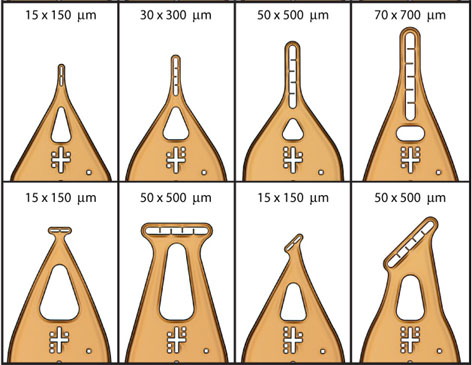TECHNOTES
Handling and Mounting Needle and Rod-Shaped Crystals
Needle and rod shaped crystals are a challenge to all researchers. They are difficult to work with; they hard to position and tend to be over-hydrated, which can lead to cracks during the flash cooling stage. The MicroLoops E™ is an revolutionary tool that have help researchers overcome these and many more difficulties.
Needle and rod shaped crystals pose special challenges. They are easily cracked and broken during retrieval. They are difficult to position over or within the aperture of standard circular-aperture loops. When loop mounted, they tend to be surrounded by too much liquid. This liquid increases background X-ray scatter; it can exert forces that crack the crystal during flash cooling; and it can crystallize to produce ice diffraction rings.
MicroLoops E™ can help you overcome these challenges. These loops have elliptical apertures that more closely match the crystal’s shape. Elliptical apertures provide just the right support to minimize cracking during retrieval and mounting, and to minimize excess surrounding liquid. Small flexible fingers within the aperture provide additional support, and allow each aperture to be used with a wider range of crystal sizes.

If cracking still occurs, use a smaller X-ray beam and search for an uncracked region with small mosaicity.
Vertical, horizontal and inclined apertures provide flexibility in sample retrieval and data collection. Vertical apertures tend to be easiest to use. Use a horizontal aperture to gently push on and then slide under a crystal that has adhered to the bottom of a well or to a glass slide
Inclined apertures can provide more efficient data collection. Rod shaped crystals must be carefully oriented in order to collect complete data sets with minimum X-ray exposure. The rod axis often corresponds to a crystal symmetry axis. If this axis lies along the spindle (rotation) axis or if the crystal is triclinic, parts of reciprocal space may be inaccessible. Dauter (Acta Cryst D (1999) 55, 1703-1717) emphasizes the value of collecting complete, high-quality data sets for improved phasing and refinement, and discusses how to orient the symmetry axis relative to the rotation axis for optimal data collection.
MicroLoops E™ with inclined apertures make it easier to place your crystal near the optimal orientation. To re-position a crystal to a better orientation, try using a MicroTip™ from MicroTools™ Kit 2. For low-symmetry crystals, use two crystals, one on a vertical loop and one on an inclined loop, to collect a complete data set.
Kappa diffractometers (available on some beamlines) allow the crystal to be rotated about any axis, and provide a more elegant solution to this problem.
Comments or suggestions? Please contact us!
